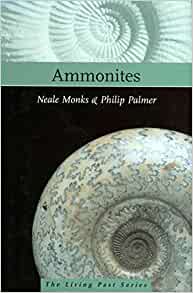By Neale Monks and Philip Palmer

I have worked (as an editor at Deposits) with Neale Monks for many years. He knows his stuff and some of that stuff is ammonites. The beautiful spiral shells of these long-extinct marine invertebrates are among the most sought after and recognisable fossils, and most fossil collectors will have examples in their collections. However, until this book was published in 2002, little had been published about ammonites other than in geological journals.
In the years since Ammonites was published, there have been many good additions to the genre, but Neale Monks and Philip Palmer’s book is still a delight. It looks at ideas on ammonite biology and ecology to present a detailed picture of a once diverse and widespread group of animals.
In this short guide, the authors describe the evolution of ammonites and their relatives, and explain how their shells were created and used as flotation devices. All the major groups of ammonites are described and illustrated (along with many minor ones), and important material is included on anatomy, feeding, reproduction, and pathology. The 300-million-year existence of ammonites ended at about the same time that dinosaurs became extinct. However, fortunately, ammonites were once so abundant that their fossilised shells can easily be found throughout the world, and the authors provide a helpful guide to locating and collecting these unique fossils.
At the time of writing, Neale Monks was a palaeontologist at the Natural History Museum in London, and had written a number of papers on the evolution of heteromorphy ammonites. Philip Palmer was also a palaeontologist at the museum until his retirement. He has written extensively on fossil molluscs and stratigraphy.
Ammonites, by Neale Monks and Philip Palmer, The Natural History Museum, London (2002), 159 pages (paperback), ISBN-13 : 978-15883404-7-4


